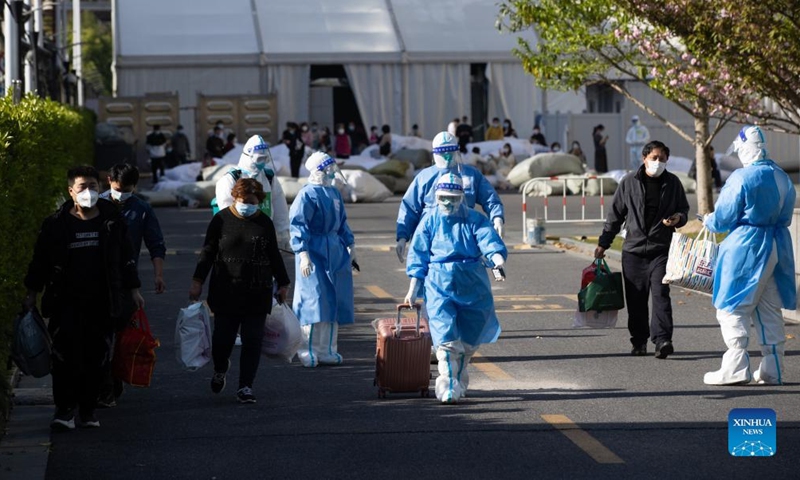Shanghai reports three deaths, all elderly, unvaccinated
Sounds alarm for China to not let guard down when battling Omicron

Patients who have recovered from COVID-19 leave a makeshift hospital converted from Shanghai Convention & Exhibition Center of International Sourcing in Shanghai, east China, April 9, 2022.Photo:Xinhua
Three deaths of COVID-19 patients reported in Shanghai, all involving unvaccinated elderly people, have sounded the alarm for China to not let its guard down when battling Omicron, and it highlights the urgency of vaccinating the elderly, said epidemiologists.
They said that the dynamic zero-COVID strategy is what has kept China's mortality rate the lowest worldwide, and the three tragic deaths in Shanghai show why such policies should be stuck to, rather than eased at the current stage.
Shanghai on Monday reported the deaths of three COVID-19 patients. The deceased, aged 89, 91 and 91 respectively, were unvaccinated, and the direct cause of death in each case was underlying diseases, Wu Qianyu, an official from the Shanghai health authority, said at Monday's press briefing.
The city, with a total population of 25 million, witnessed more than 300,000 infections since March, with only three deaths.
Those three deaths serve as an alarm for the country not to let its guard down in the face of Omicron, as it is extremely dangerous for unvaccinated vulnerable groups with underlying diseases, a senior expert from the Chinese Center for Disease Control and Prevention (CDC) told the Global Times on condition of anonymity, noting that this is a fundamental reason why many epidemiologists agree not to ease the current antivirus strategy.
He said that the deaths highlight the urgency of vaccinating the elderly. "Currently, minors and the elderly are the key groups for the government to care for."
On Friday, Shanghai government officials revealed that only 62 percent of the city's 3.6 million elderly - aged 60 and above - are fully vaccinated. The rate of those getting booster shots accounts for merely 38 percent.
China has reported fewer than 5,000 deaths ever since the COVID-19 outbreak began two years ago. Most of the deaths occurred during early 2020.
During the current outbreak, Northeast Jilin Province reported the deaths of two elderly COVID-19 patients, yet the virus wasn't the direct cause of their deaths.
In sharp comparison, ever since the initial outbreak, the death toll in the US has topped 986,000 and the number in the UK has surpassed 170,000. Globally, the coronavirus has killed at least 6.2 million people.
China's top respiratory expert Zhong Nanshan said during a conference in November 2021 that the death rate of COVID-19 in China was 0.4 per 100,000, the lowest in the world, and 1/606 of that of the US.
Wu Zunyou, chief medical expert at China's CDC, said at an April 6 conference that China has been able to keep death rates low because of its efforts to detect and curb outbreaks at an early stage, high vaccination rates and an approach of treating all infected patients, which he said had helped prevent mild cases from turning into severe ones.
Ma Xiaowei, director of the National Health Commission, wrote in an article in the Party-linked newspaper the Study Times on Monday that local officials across the country should resolutely oppose the wrong claims such as "coexisting with COVID" or "the virus is becoming the flu,'' and adhere to the country's dynamic zero-case policy to achieve results at a minimum cost.
Recently, some Western media, including the Financial Times and Wall Street Journal, jumped on China's low mortality rate, casting doubts as to whether China underreported its deaths. They made such speculation mainly on the basis that China adopted different standards as to what counts as a COVID-19 death.
In principle, China counts those who died before reaching the standard of having recovered from COVID-19, as COVID-19 deaths, a source close to the authority told the Global Times, on condition of anonymity.
The person explained that only confirmed COVID-19 cases can be counted as COVID-19 deaths, not asymptomatic patients. China counts confirmed COVID-19 patients and silent carriers separately.
Those who contracted the virus, but died after having reached the criterion of recovery from COVID-19, are also excluded from COVID-19 death counts.
China's catogorization of counting COVID-19 deaths is based on science and responsible and cautious attitude, as any distortion of COVID-19 data violates the rules of contagious disease and then gives the public unnecessary panic and misguide health authorities' judgment of the outbreak,Wang Guangfa, a respiratory expert at Peking University First Hospital, told the Global Times.
Although countries have different standards in counting COVID-19 deaths, there's no perfect way to categorize this, said Wang, attributing the reason to difficulties of pinpointing the direct cause of any death.
A paper published by The Lancet in March said that the number of people who died because of the pandemic may be three times higher than the official death toll, for reasons such as lack of access to COVID-19 tests, patchy records of causes of death, and so forth.
Wang believed that since mortality statistics are fundamental to public health decision-making, China is taking a serious and scientific attitude to its COVID-19 numbers. He said that foreign media's hyping is just throwing mud at China, and won't change the fact that China has seen the lowest mortality rate worldwide.
"Even hyping the different standard fails to explain the huge gaps of death rates between China and certain Western countries," he noted.


